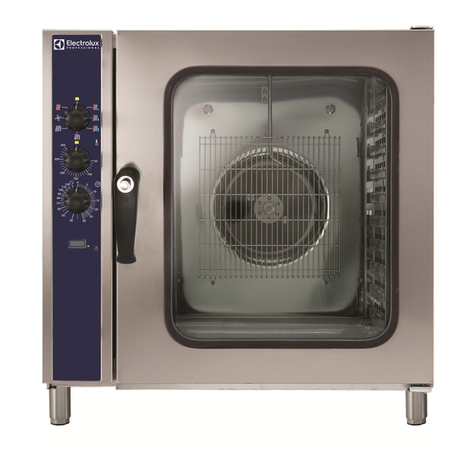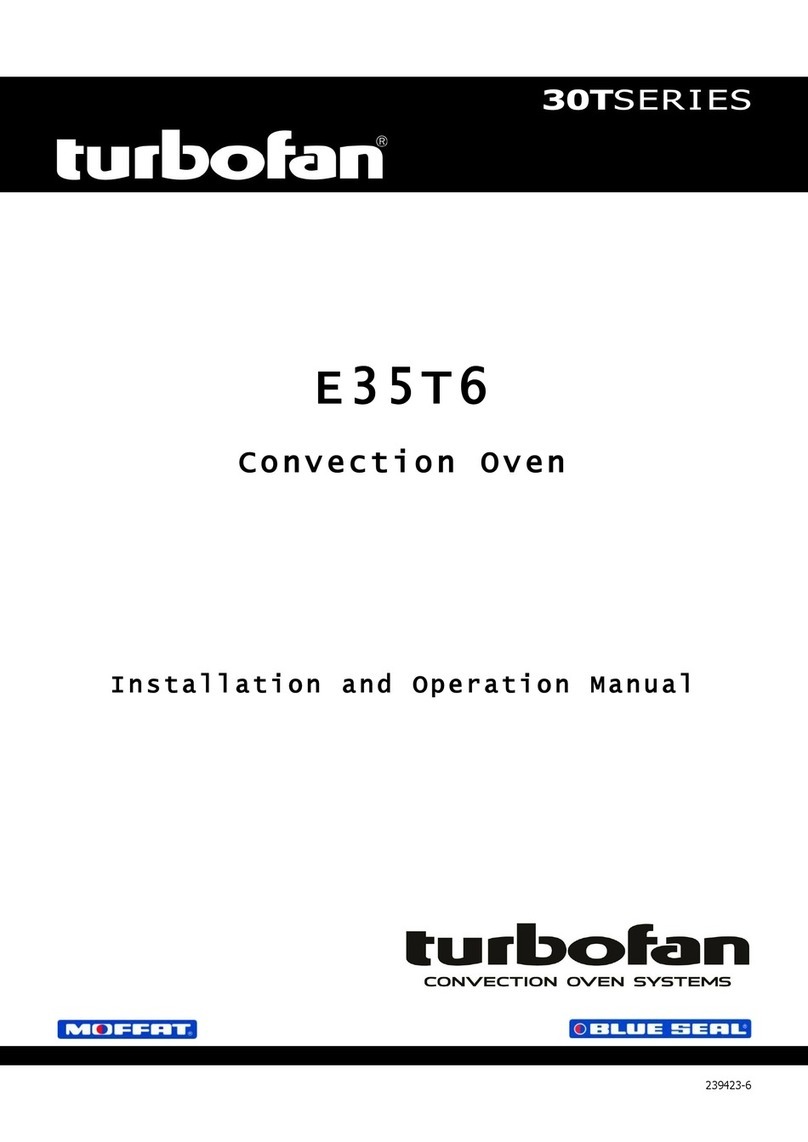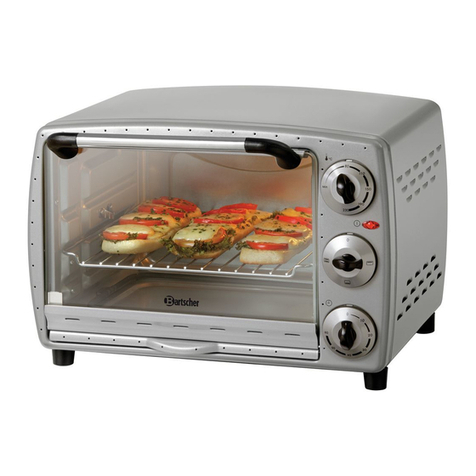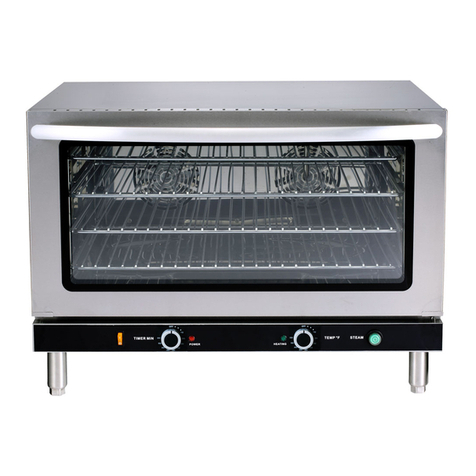Tecnoinox PFR8V7/1 User manual

PFR8V7/1
4 ROUND HERMETIC HOT PLATES ELECTRIC ON GN1/1 ELECTRIC CONVECTION
OVEN WITH 1 GRID (DIAM 22CM - 8.7IN)
716084
CODE
DESCRIPTION
MODEL
13-03-2023 12:11

EN - 1
5410.256.08
Part 1 – Installation
COOK TOPS AND ELECTRICAL COOKERS WITH ELECTRIC OVEN
General warnings
The manufacturer declines any liability
for damage caused by improper or incorrect
appliance installation or maintenance, or
failure to observe the safety regulations.
The appliance referred to in this
instruction manual has been manufactured
in conformity with the requirements of the
European Directives on Low Voltage and
Electromagnetic Compatibility.
The appliance must be installed by a
qualified technician according to the
regulations and directives in force in the
country of use, following the instructions in
this manual.
The appliance can operate with a
50Hz or 60Hz power supply without
modifying the wiring or the internal
components. Please see the technical data
on the rating plate for the voltage.
This appliance has been designed
exclusively to cook food in professional
kitchens such as those in restaurants,
canteens and hotels. This appliance is not
designed for mass, continuous food
production. All other uses are considered
improper.
The appliance must never be left
unattended when it is being used.
The appliance must be installed so as
to prevent water from coming into contact
with the cooking plate.
The appliance is designed for
professional use and therefore should only
be used by qualified personnel.
Be careful when using the appliance
because the cooking surfaces are very hot.
The appliance should be installed
under an extractor hood for evacuating
cooking vapours.
Install the appliance on a floor or flat
surface. Avoid slopes of more than 5° to keep
it stable.
Whenever the appliance is moved, for
example to be transported, written off and
scrapped, take care not to tilt the appliance
more than 5° to keep it stable.
The appliance, and especially the
power lead, must not be installed anywhere
near heat sources.
Disconnect devices must be
incorporated into the fixed wiring, in
accordance with wiring guidelines.
The temperature of the environment
in which the appliance is installed must not
exceed 50°C.
Do not open the control panel or
touch the electrical components. Contact
the technical support service.
If the power cable is damaged it must
be replaced by the manufacturer, technical
support, or a similarly qualified person, in
order to avoid any hazards.
Switch the appliance off during
maintenance or when parts are being
replaced.
When using the appliance, wear oven
gloves and clothing that covers the entire
body.
The floor around the appliance may
become slippery.
Switch the appliance off in the event of a
fault or malfunction.
Please be extremely careful and
contact the technical support service if any
parts or components come loose.
The oven should also be checked
once a year by a qualified technician.

EN - 2
5410.256.08
The surfaces in contact with the
appliance must be covered with heat-
insulating material.
To prevent accidental contact with
hot parts, fit the 2 thermal protection plates
(labelled Bin the figure below) on the sides
of the cooking top. Follow the relevant
instructions to fit them. The thermal
protection side plates are provided, and can
also be ordered at a later date.
For Australia and New Zealand only:
the fixed system must be equipped with a
protective device compliant with standard
AS/NZS 3000.
If the appliance is installed in line:
Respect the minimum clearance
distance of 80 mm between the appliance
and any walls made of flammable material,
partitions, kitchen furniture or nearby
equipment.
For cook tops installed on the work
surface:
For models 800 mm wide or less only,
fix the feet in position respecting a
minimum clearance distance of 80 mm from
any walls made of flammable material,
partitions or nearby equipment.
For cook tops installed on their own, on
the floor and separate from other
equipment:
For models 800 mm wide or less only,
to ensure electrical appliances positioned
on the floor are vertically stable, fix a bracket
to the floor to anchor the appliance down
(labelled Ain the figure below). Follow the
relevant instructions to fit them. The bracket
is provided, and can also be ordered at a
later date.
Electrical connections
Remove the appliance packaging as well as the protective plastic sheet. If
necessary, remove any traces of glue with a suitable solvent. Please
comply with local legal provisions when disposing of the packaging.
When installing the appliance, please observe the following regulations:
applicable laws in force;
European, national, regional and/or local regulations;
directives and regulations stipulated by the local electricity supplier;
accident-prevention regulations in force;
fire-prevention regulations.
Before connecting the electrics, take note of the technical
specifications such as voltage, frequency, number of phases and
power required for installation. This information can be found on
the appliance data plate.

EN - 3
5410.256.08
Power supply features:
The alternating current power supply to the appliance must meet
the following conditions:
Maximum voltage variation ± 10%
Maximum frequency change ± 1% in continuous ± 2% for a
short period of time.
The appliance power supply must be protected against
overcurrent (short circuits and overload) with fuses or properly
sized circuit breakers.
The installer must connect up the appliance by positioning an
easily accessible main switch that disconnects all poles supplying
electrical power to the appliance. When contacts are open, there
must be a minimum distance of 3 mm between the poles.
The cable:
must not be installed near heat sources and the ambient
temperature of the surrounding environment must not exceed
50°C;
must be protected by a rigid metal or plastic tube;
must meet H07 RN-F standards as a minimum;
must have a minimum cross section as indicated on the cover.
In reference to figure 1, to access terminal board “M”, remove the
control panel by loosening the screws on the panel. Connect the
power cable wires to the terminal board by following the
instructions provided in the wiring diagram.
The appliance must be connected to an efficient earth. Connect the earth
conductor to the screw marked with the symbol “ ” close to the
connection terminal board. Be careful to pass the cable through the “P”
cable gland near the terminal board; keep the cable laid flat on the bottom
and fix it with the “ ” cable clamp. The appliance must also be included in
an equipotential bonding system. This connection is made using a screw
marked with the symbol.
The equipotential wire must have a cross section of 10 mm2.
The manufacturer declines any liability
for damage caused by improper or incorrect
appliance installation or maintenance, or
failure to observe the safety regulations.

EN - 4
5410.256.08
Part 2 – Use
General warnings
The appliance is designed for
professional use and therefore should only
be used by qualified personnel.
Be careful when using the appliance
because the cooking surfaces are very hot.
The appliance must never be left
unattended when it is being used.
Switch the appliance off in the event
of a failure or malfunction.
Be careful when using the appliance
because the cooking surfaces are very hot.
The plates are provided with a
temperature limiter that stops the electricity
supply when the temperature reaches
450°C; the limiter restarts automatically.
We recommend using pans with a flat
bottom, switching the plate on after
positioning the pan and avoiding spilling
cold liquids on the hot plate.
Switching on the electric plates
Press the switch positioned before the appliance.
Turn dial “A” corresponding to the desired plate to align the
marker on the control panel with the position selected. The
green light “B” will light up.
Maximum power is position “6” and minimum power is
position “1”.
On start-up, turn the dial to “6”; once the maximum cooking value
is reached, turn the dial to a lower position.
0 1 2 3 4 5 6
Switching off the electric plates
Turn the dial to the off position “0”. Switch the power off using the switch positioned before the
appliance.
Switching on the static electric oven
The heating elements are controlled by a 4-position
selector. The internal chamber temperature is controlled
by a thermostat (60°C-300°C).
The dial is used to choose the most suitable heating mode,
activating the heating elements as required.
Turn the heating element control dial “C” to one of the
enabling positions. The green indicator light “E” lights up
to indicate that the machine is powered up.
Turn the thermostat dial “D” to the desired cooking
temperature marker. The orange indicator light “F” lights
up to indicate that the heating elements are in operation.
The oven door must be closed during
all cooking procedures.
0
OFF Lower and upper
heating elements
Upper heating
element
Lower heating
element
60°C 100°C 140°C 180°C 220°C 270°C

EN - 5
5410.256.08
Switching on the fan electric oven
Turn the thermostat dial “D” to the desired cooking temperature
marker. The green indicator light “E” lights up to indicate that the
machine is powered up and the fans are running. The orange
indicator light “F” lights up to indicate that the heating elements
are in operation.
0 60°C 100°C 140°C 180°C 220°C 270°C
Switching off the electric oven
Turn dials “C” and/or “D” to position “0”. Switch the power off using the switch positioned before the
appliance.
Safety thermostat
Electric ovens are fitted with a safety thermostat that cuts off the
electric power supply in the event of a fault or overheating.
To turn the appliance on again, remove the control panel, taking out the
screws located in the lower part, and press button “G”.
Contact a specialist technician.

EN - 6
5410.256.08
Part 3 – Maintenance and cleaning
Replacing parts
Faulty parts should only be replaced by qualified personnel. First, always disconnect the appliance from the gas and electric mains. After having
removed the control panel, all the functional parts of the appliance are easily accessible.
Only order spare parts from the manufacturer or an authorised dealer.
FAULTS
Malfunctions are not always due to the quality of the components used. These appliances are manufactured using top-quality components.
Malfunctions may be caused by voltage surges or by infiltrations of dust and/or dirt. In any case, if you suspect their is a fault, ALWAYS turn the
appliance off and call the authorised repair service.
Unauthorised persons should never attempt to repair the appliance or carry out
maintenance. Tampering with the appliance voids the warranty.
MAINTENANCE – TESTS – CHECKS – CLEANING FREQUENCY USER
SUPPORT
SERVICE
Cleaning
General cleaning of the appliance and the
surrounding areas
Daily or based on the
degree of use
Yes -
Safety devices
Check the safety devices function correctly Monthly Yes Yes
Mechanical protective
devices
Check condition. Check that there are no
deformations or loose/missing parts.
Monthly Yes Yes
Controls
Check the readability and condition of the
inscriptions and symbols. Repair if necessary.
Yearly
Yes Yes
Appliance structure
Check the mechanical part to make sure that
it is not broken or deformed. Check the screws
are tightened.
Yes Yes
Tighten the main bolts (screws, fasteners, etc.)
on the appliance
- Yes
Safety signs
Check the readability and condition of the
safety signs.
Yes Yes
Electrical control panel /
electronics
Check the condition of the electrical parts
installed on the electrical control panel.
- Yes
Check the wiring between the electrical panel
and the parts of the appliance.
Electrical connection
cable and plug socket
Check the condition of the connection cable
and plug socket.
Yes Yes
Replace if defective.
-
Yes
Motor bearings (if
present)
Replace motor bearings Every three years - Yes

EN - 7
5410.256.08
Cleaning and care
Only clean the appliance once it has
cooled.
Only use products that are food safe.
Use personal protective equipment (PPE)
when cleaning.
Do not wash the appliance with jets of
water. Any water entering the electric
components could lead to a malfunction.
Read the warnings provided on the detergent safety data sheets.
Keep the appliance clean to ensure it functions correctly and lasts
for a long time. Wash the removable parts separately with warm
water and detergent, then rinse them under running water. Clean
the steel parts with a damp cloth and a non-abrasive detergent,
then dry them using a soft, dry cloth. For stubborn deposits, use
hot water and vinegar. Do not use harsh or abrasive detergents to
clean the stainless steel parts. Do not use iron cleaning pads as they
may cause rust to form. For the same reason, avoid contact with
ferrous materials, heavy or coarse cloths, or steel wool.
When cleaning, avoid using abrasive paper or cloth. Only in special
cases, use pumice stone powder instead. For stubborn deposits,
we recommend using a sponge (e.g. Scotch-Brite). You can also
use oven and grill cleaning sprays, readily available on the market,
to remove stubborn deposits. If you use spray products, please
follow the manufacturer’s instructions. Do not use abrasive or acid
products on enamelled parts and do not clean using steel wool or
metal pads. Clean the oven after use. This will make it easier to
remove any residue, which would otherwise burn and cause bad
odours the next time you use the oven. To minimise emissions of
polluting substances into the environment, clean the appliance
with products that are at least 90% biodegradable.
Ecology and the environment
Our appliances are studied and optimised via testing to provide
high performance and yields. To reduce energy consumption
(electricity, gas and water), do not use the appliance for long
periods of time without food inside or in conditions that may
compromise optimum yield.
All of the following materials are used for the packaging:
•Polyethylene: external packaging film and/or bubble wrap
•Polypropylene: straps
•Expanded polystyrene: corner pieces, protective sheets and
blocks
•Cardboard
•Wooden base frame
These materials are environmentally friendly and can be safely
stored or reused/recycled. Should you wish to dispose of them,
please adhere to the waste regulations in force in your country.
Dispose of the appliance responsibly at the end of its
useful life.
In compliance with the regulations in force in your
country, dispose of the waste product by taking it to an authorised
collection and treatment site, after removing the power cable.
This manual suits for next models
1
Table of contents
Popular Convection Oven manuals by other brands

Aroma
Aroma AeroMatic AST-910DX Instruction manual & recipe guide
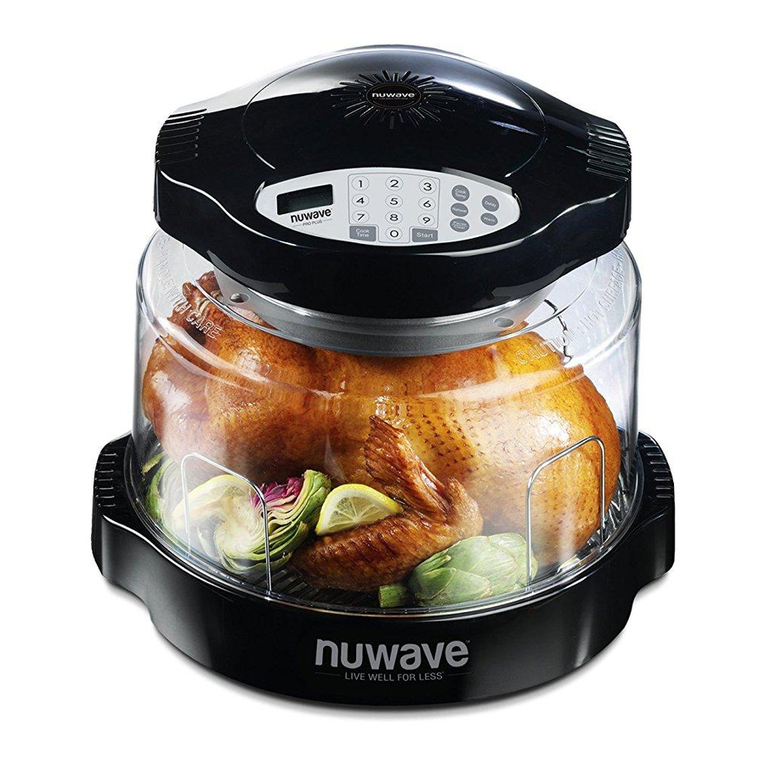
NuWave
NuWave Pro Plus Manual and cookbok

KitchenAid
KitchenAid KEBS278AAL1 parts list
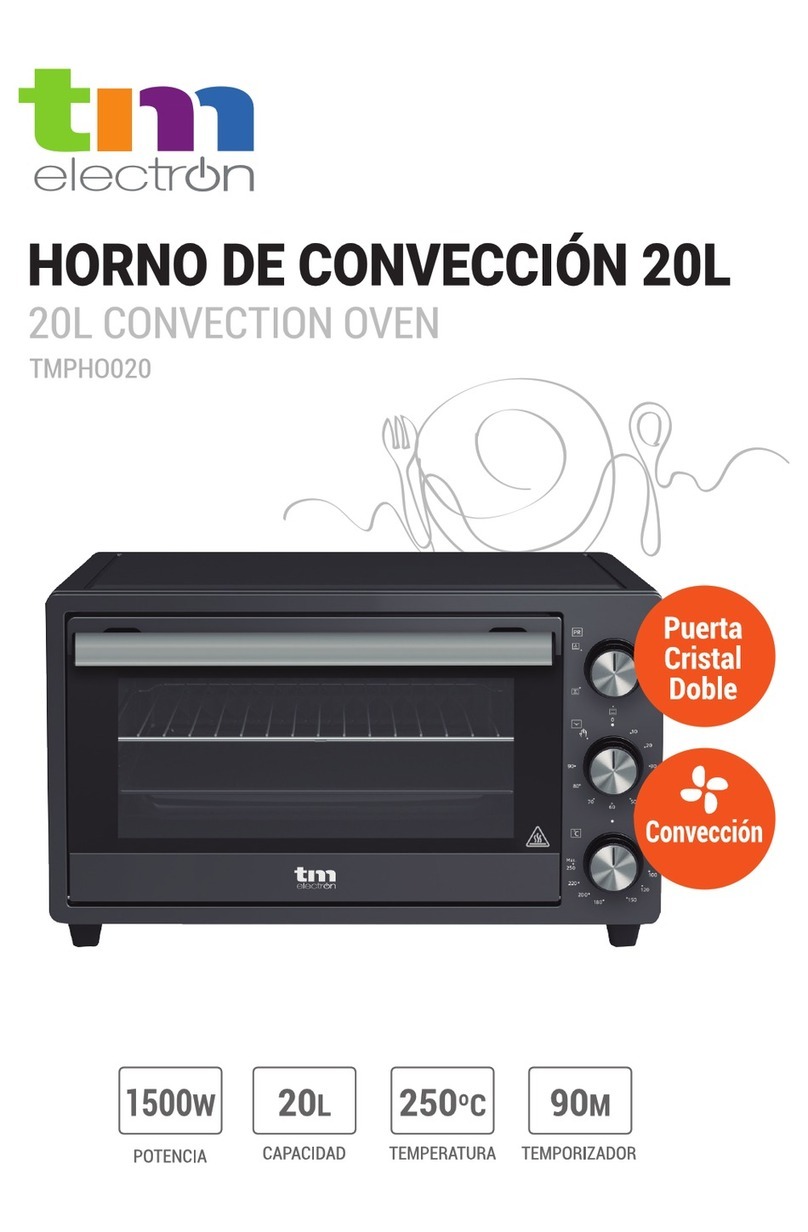
TM Electron
TM Electron TMPHO020 manual

Inoksan
Inoksan FBG020 instruction manual

Manitowoc
Manitowoc U.S. Range Summit SUME-100 Installation, operation and maintenance manual

KitchenAid
KitchenAid 9759536B installation instructions
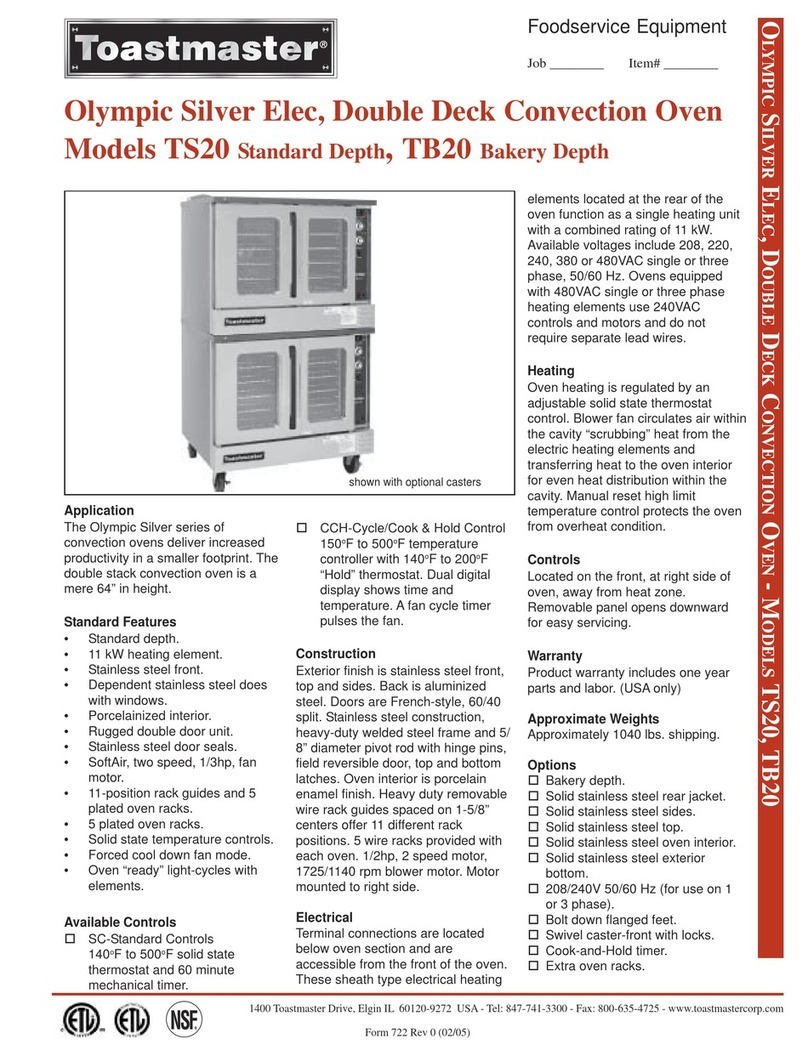
Toastmaster
Toastmaster TB20 brochure
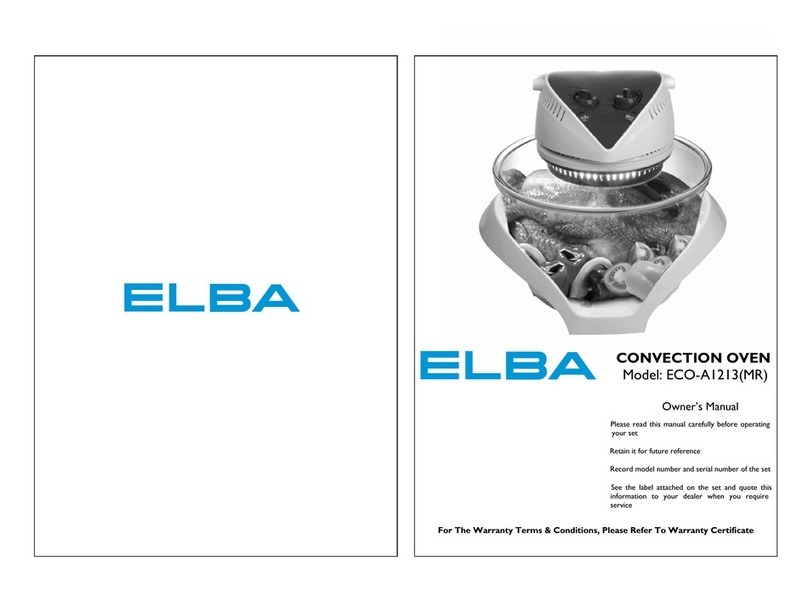
Elba
Elba ECO-A1213 owner's manual
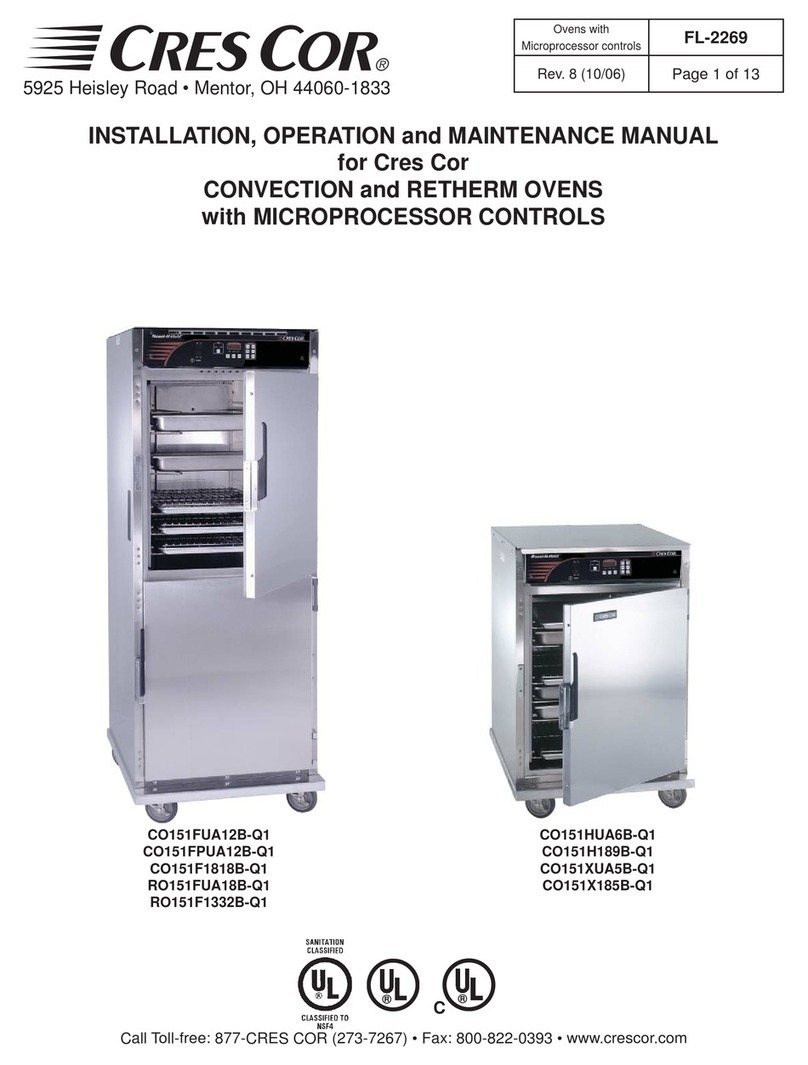
Cres Cor
Cres Cor CO151H189B-Q1 Installation, operation and maintenance manual
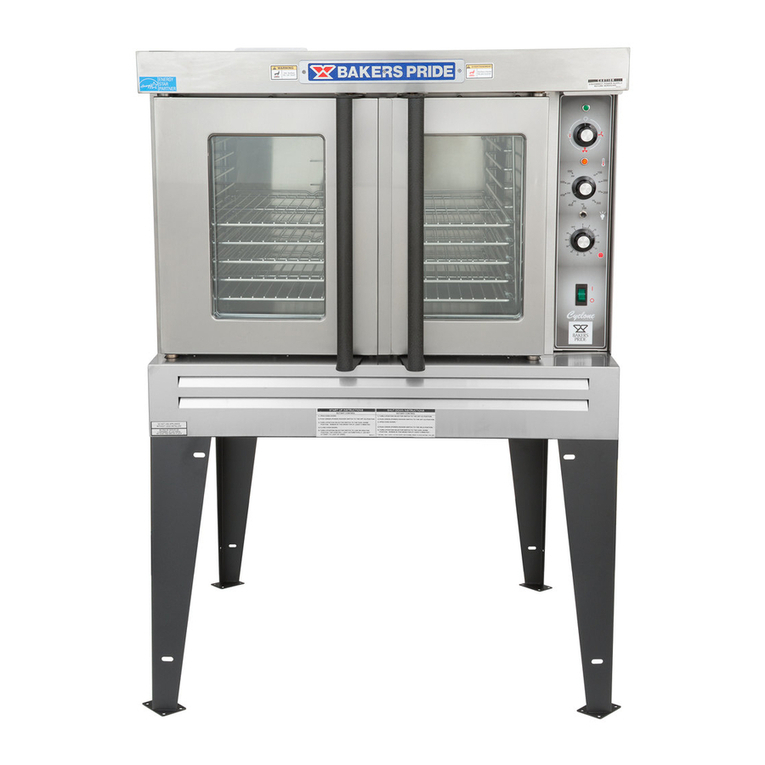
Bakers Pride
Bakers Pride BCO-E Installation and operating instructions
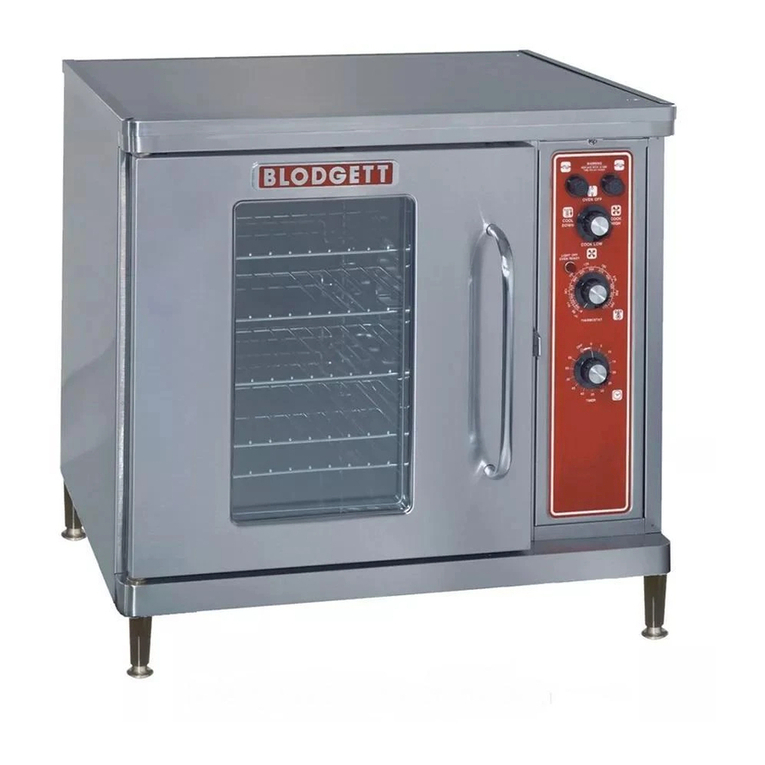
Blodgett
Blodgett CTB SERIES Replacement parts list
